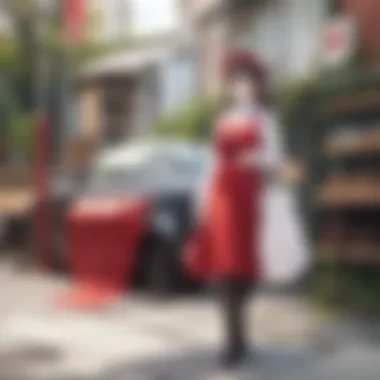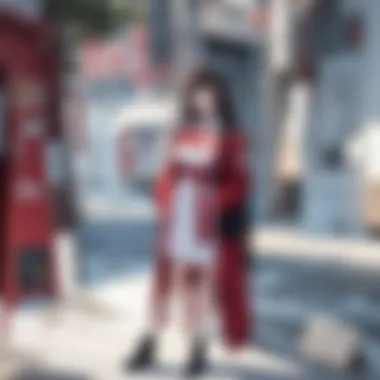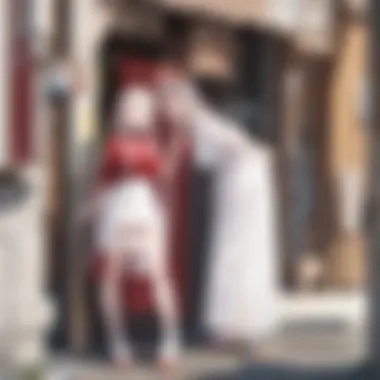Exploring Ragu Ga: Origins and Cultural Significance


Intro
Ragu Ga represents a notable phenomenon in the anime and manga worlds. Understanding its significance requires delving into the character dynamics and thematic elements that define this concept. Ragu Ga intertwines with prevalent narratives, offering insights into character development and cultural context. As fans explore Ragu Ga, they uncover layers that reflect broader trends in storytelling methods within Japanese media.
Character Analysis
Character analysis plays a pivotal role in grasping the essence of Ragu Ga. It is through the lens of character growth that audiences appreciate the intricacies of these narratives.
Overview of Character Development
In examining Ragu Ga, one must consider how characters evolve throughout their journeys. The development of protagonists often reflects their struggles, motivations, and transformations. Each character's path provides a rich tapestry, illustrating their responses to societal expectations and personal conflicts. A well-rounded character in Ragu Ga bears witness to the nuances of human experience.
Key Relationships and Dynamics
Interactions among characters hold substantial weight in Ragu Ga narratives. The relationships often reveal deeper societal themes. Conflicts, alliances, and evolving dynamics can highlight cultural perspectives in a fascinating way. Understanding these relationships enhances one’s appreciation of character depth and thematic relevance.
Thematic Exploration
Themes in Ragu Ga extend beyond surface-level narratives, revealing the rich cultural canvas that shapes the stories.
Central Themes and Messages
Ragu Ga encapsulates a plethora of themes, often addressing identity, belonging, and the clash between personal desires and communal duty. These central messages resonate profoundly with audiences, driving home the idea that personal journeys are intertwined with larger social frameworks. It is a compelling commentary on the human condition.
Cultural Context and Influences
The cultural influences in Ragu Ga are significant in propelling the narrative forward. From Japanese folklore to contemporary societal issues, these elements inform story arcs and character motivations. Familiarity with these cultural references is essential for a full understanding of the impact and appeal of Ragu Ga.
"Ragu Ga stands as a reflection of collective narratives, inviting audiences to explore deeper meanings within their favorite anime and manga."
The enduring nature of Ragu Ga invites ongoing dialogue and investigation. As one navigates through its characters and themes, they gain insight into a rich tradition of storytelling that continues to evolve. Understanding Ragu Ga is not merely an academic endeavor; it is a journey into the heart and soul of anime and manga narratives.
Preamble to Ragu Ga
Ragu Ga holds a significant place in the landscape of anime and manga, representing both a unique narrative style and a collection of cultural references. This article seeks to explore Ragu Ga comprehensively, uncovering its intricate layers and broad appeal. Understanding this topic is essential for enthusiasts who wish to delve deeper into its nuances, cultural resonance, and artistic implications.
In today's rapidly evolving media landscape, Ragu Ga serves as a bridge connecting traditional storytelling with contemporary themes. This exploration will cover various aspects including its definition, historical significance, and how it translates into popular elements of Japanese media.
Defining Ragu Ga
Ragu Ga can be defined as a unique narrative form that incorporates specific elements from traditional Japanese art and storytelling. It combines linear storytelling with rich character development and thematic depth. Ragu Ga is characterized by a specific aesthetic, often showcasing detailed visuals and nuanced character arcs. This form of artistic expression is not just about visual appeal; it also reflects deeper societal themes and emotional experiences shared by characters.
When discussing Ragu Ga, one must consider both the visual and narrative components that make it distinct. The elegance of its presentation often brings viewers into a world that resonates on multiple levels. It builds connections with audiences by exploring universal themes such as identity, love, and conflict.
Historical Context of Ragu Ga
To understand Ragu Ga fully, one must examine its historical development. Its roots can be traced back to ancient Japanese literature and art forms that highlight storytelling's importance in cultural heritage. Over the years, various influences have shaped Ragu Ga, including changes in society and advancements in technology.
In the early stages of Japanese anime and manga, there was a blend of traditional motifs with modern storytelling techniques. This evolution allowed Ragu Ga to emerge as a response to changing cultural dynamics. The introduction of color, animation, and digital elements contributed to its formation.
It is crucial to note how Ragu Ga has adapted over time by absorbing influences from global storytelling trends while maintaining its unique identity. This adaptability ensures that while the core essence of Ragu Ga remains intact, it continues to engage new generations of audiences effectively.


Understanding Ragu Ga provides insights into the broader trends in narratives and character development within Japanese media.
In summary, the introduction to Ragu Ga serves as a foundational exploration of its defining characteristics and historical context. By examining these aspects, we gain a clearer perspective on its cultural significance and ongoing influence in anime and manga.
Cultural Significance of Ragu Ga
The cultural significance of Ragu Ga transcends mere entertainment; it serves as a vital conduit for exploring complex social themes and traditional narratives. As a unique art form within the expansive domains of anime and manga, Ragu Ga reflects and often critiques contemporary societal norms. This discussion explores specific elements and numerous benefits of Ragu Ga, delving deep into its impact on both creation and consumption of Japanese media.
Influence on Japanese Media
Ragu Ga has a profound influence on Japanese media, shaping genres and altering narratives. Its popularity has prompted numerous adaptations and inspired creators to innovate their storytelling techniques. The explosion of digital platforms has further amplified Ragu Ga's reach, allowing broader audiences to engage with its narratives. Yet, it is essential to understand how its themes resonate within broader contexts. The tropes commonly associated with Ragu Ga, such as heroism, conflict, and redemption, have become staples in many modern anime and manga series. Moreover, the character-driven plots foster a deeper emotional connection, often resulting in lasting impact.
Connections to Japanese Folklore
The roots of Ragu Ga are intricately linked with Japan's rich folklore. Many stories borrow elements from ancient tales, legends, and mythologies. This connection not only preserves cultural heritage but also enriches the storytelling experience. For instance, characters may embody archetypes derived from traditional folklore, promoting recognition among audiences familiar with these stories. When creators weave these elements into contemporary narratives, they bridge the gap between past and present, cultivating a unique form of storytelling.
According to historians, these interactions with folklore shape modern narratives, igniting new interest in age-old traditions. Fans might discover that a character’s journey parallels a legendary hero's plight, awakening their curiosity about origins and context. This intertextuality enhances appreciation for Ragu Ga, as it allows audiences to see the evolution of motifs across various media.
"Ragu Ga serves not only as a storytelling device but also a means to preserve and reflect cultural values that resonate through generations."
Thematic Elements of Ragu Ga
The thematic elements of Ragu Ga are crucial in understanding its depth and impact within the narrative frameworks of anime and manga. Themes act as the backbone of any story, guiding the audience through core messages, emotional undertones, and moral lessons. Ragu Ga, with its unique approach, enriches storytelling by integrating complex themes that resonate with audiences on multiple levels. The exploration of these themes can lead to a more satisfying viewing or reading experience, encouraging reflection and discussion.
Exploration of Core Themes
Ragu Ga showcases several core themes that are interwoven throughout its narratives. These themes often include the struggle between good and evil, the quest for identity, and the exploration of friendship and loyalty. Each theme not only propels the plot forward but also shapes character development.
- Good vs. Evil: Many Ragu Ga narratives highlight this struggle, portraying protagonists facing seemingly insurmountable odds. This theme encourages viewers to engage with moral dilemmas and question their values.
- Identity: Characters often undergo journeys to find themselves, which reflects a universal pursuit. The exploration of self-discovery resonates deeply, especially among younger audiences.
- Friendship and Loyalty: Central to many plots, these themes foster connections among characters, thus enhancing emotional stakes and making the audience more invested.
Critically, these themes are not merely superficial. They prompt audiences to consider broader societal issues such as personal integrity, the nature of evil, and the importance of interpersonal relationships. By delving into these themes, Ragu Ga offers a layered narrative that invites deeper understanding.
Character Motivations and Development
Character motivations in Ragu Ga are intricately linked to the thematic elements of the story. Each character's journey is affected by their desires, fears, and the external conflicts they face. This development is essential in presenting believable narratives that engage audiences.
- Protagonists: Typically, Ragu Ga protagonists are driven by strong motivations. They might seek revenge, freedom, or knowledge. Understanding these motivations helps the audience connect with and empathize with the characters.
- Antagonists: On the other hand, antagonists present opposing ideologies. Their motivations are often defined by their past experiences or inherent beliefs. This duality enriches the narrative, providing conflict that is both literal and philosophical.
Through their journeys, characters in Ragu Ga undergo significant changes, illustrating growth, redemption, or even tragic flaws. This development is not just for the sake of plot advancement; it mirrors real-world complexities, making the characters relatable and their stories meaningful.
The careful construction of character arcs in Ragu Ga leads to a satisfying narrative resolution that resonates with viewers, often prompting introspection and discussion.
In summary, the thematic elements of Ragu Ga serve as a framework for understanding the unique narratives within this genre. Through a combination of exploration of core themes and character motivations, Ragu Ga continually captivates audiences, ensuring its relevance in the ever-evolving landscape of anime and manga.
Ragu Ga across Different Genres
Ragu Ga demonstrates a remarkable versatility that transcends genres within Japan's anime and manga landscape. Understanding its multifunctional role provides insight into how narratives employ this concept to enrich character development and thematic depth. Across various formats, Ragu Ga influences storytelling through diverse perspectives and structures. This section explores its manifestation in Shōnen series, Shōjo stories, and Isekai narratives, elucidating the unique characteristics and implications of each genre.
Ragu Ga in Shōnen Series
Shōnen series are known for their action-oriented storytelling, frequently targeting a younger male audience. In this context, Ragu Ga often finds itself intertwined with themes of heroism, competition, and personal growth. Characters typically face external adversities while navigating their internal struggles, creating a layered narrative.
Key elements of Ragu Ga in Shōnen include:


- Character motivations: Many protagonists exhibit a strong desire to improve themselves, rooting their actions in the Ragu Ga philosophy. This sense of continual growth resonates deeply with viewers, particularly young males seeking relatable experiences.
- Conflict resolution: Ragu Ga serves as a lens through which characters confront their challenges. The resolution of conflicts reflects personal character arcs, highlighting key moments of self-discovery.
- Friendship dynamics: Relationships often serve as pivotal supporting structures within these narratives. The interplay of friendships emphasizes the importance of collaboration and mutual understanding, underscoring the social component of Ragu Ga’s framework.
Ragu Ga in Shōjo Stories
Shōjo stories, on the other hand, present a distinctive narrative landscape that emphasizes emotional depth and romantic themes. Here, Ragu Ga plays a crucial role in illuminating character interactions and personal dilemmas. The focus shifts towards subtle emotional conflicts, rather than overt action.
In Shōjo narratives, Ragu Ga manifests through:
- Exploration of relationships: The dynamics between characters, particularly in romance, are accentuated through Ragu Ga. The interplay of feelings invites readers to empathize deeply with character struggles and aspirations.
- Self-discovery: Female protagonists often undergo significant transformation and self-realization, driven by external influences and personal relationships. Ragu Ga enhances their journeys, showcasing growth in a more intimate and emotional way.
- Cultural reflections: Elements unique to female perspectives provide valuable commentary on societal expectations and gender roles, making Ragu Ga an effective tool for highlighting these themes.
Ragu Ga in Isekai Narratives
Isekai narratives introduce another dimension to Ragu Ga, as they often involve characters transitioning to alternate worlds. This genre frequently explores themes of escapism and fantasy, while simultaneously delving into identity and existential questions.
Ragu Ga in Isekai stories includes:
- World-building: The introduction of new realms allows for fresh interpretations of Ragu Ga. Characters adapt to unfamiliar environments, illustrating their capacity for resilience and flexibility.
- Identity exploration: As they inhabit different roles in these new worlds, protagonists often grapple with their past selves while discovering new facets of their identities. Ragu Ga facilitates this exploration, illuminating how their experiences shape them.
- Narrative flexibility: The genre’s inherent diversity encourages varied expressions of Ragu Ga, allowing for layered story arcs that can blend action, romance, and philosophy.
Ragu Ga is not a static concept; it evolves dynamically within these genres, shaping and reshaping narratives in ways that resonate deeply with audiences.
Character Analysis within Ragu Ga Framework
Character analysis within the framework of Ragu Ga is essential for comprehending the intricate relationships and dynamics that drive the narratives in this genre. By studying characters, both protagonists and antagonists, enthusiasts can uncover deeper meanings within the story, which in turn elevates the overall appreciation of Ragu Ga's impact on anime and manga. Understanding character arcs and motivations reveals how they reflect societal themes and cultural nuances. This analysis not only enhances the enjoyment of the content, but also enriches discussions among fans and scholars alike.
Protagonists and Their Arcs
Protagonists in Ragu Ga often undergo significant development, displaying their growth throughout the narrative. This character evolution is crucial as it highlights their journey and challenges faced along the way. For instance, many protagonists start from a place of insecurity or unfulfillment, facing trials that push them to evolve. Their arcs typically exhibit a transformation that reflects personal values and societal expectations.
One notable example involves the protagonist from Your Lie in April, who begins as a withdrawn character haunted by past trauma. As the story progresses, their interactions with other characters catalyze emotional healing and self-discovery. This journey serves not only as entertainment but also as a mirror to real-life struggles and triumphs.
When dissecting protagonist arcs, we can consider aspects such as:
- Motivation: What drives the character to pursue their goals?
- Conflict: What obstacles must they overcome?
- Resolution: How do they change by the story's end?
These elements create rich narratives that resonate with audiences, emphasizing the profound impact of character development in Ragu Ga.
Antagonists and Their Role
Antagonists serve a crucial function within Ragu Ga narratives, often representing opposition to the protagonist's goals. Their presence is not merely to create conflict but to challenge and, at times, deepen the protagonist's characteristics. A well-crafted antagonist can transform a simple conflict into a complex confrontation of principles, morality, and self-identity.
Consider the antagonist in Naruto, who embodies ideals that contrast sharply with those of the main character. Their confrontations illustrate deeper philosophical questions about peace, unity, and the nature of human conflict. This dynamic often leads to pivotal moments that cause protagonists to reevaluate their own beliefs and motivations.
Key aspects of analyzing antagonists include:
- Their backstory: What shaped their motivations?
- Function in the plot: How do they facilitate the protagonist's growth?
- Complexity: Do they present a moral ambiguity that challenges the audience's perception?
In summary, both protagonists and antagonists in Ragu Ga contribute significantly to the narrative's depth. Understanding their roles provides insights into the thematic richness of the genre, fostering a deeper connection between the audience and the storytelling.
Artistic Styles Associated with Ragu Ga
The artistic styles associated with Ragu Ga play a crucial role in shaping its identity within the broader landscape of anime and manga. Artistic expression defines not only the aesthetic appeal but also influences narrative delivery and audience engagement. Each style brings with it unique elements that reflect cultural, thematic, and emotional undercurrents of the stories being told.


Visual Elements in Ragu Ga
Visual elements in Ragu Ga encompass a range of artistic choices that impact overall storytelling. These choices include character design, color palettes, and scene composition.
- Character Design: The characters often exhibit distinctive features that align with their personalities and roles. For example, protagonists may have exaggerated elements like larger eyes while antagonists might be designed with darker color schemes. This design approach aids in quick identification and empathy with viewers.
- Color Palettes: Colors set the mood. Bright, vibrant colors may evoke feelings of joy and adventure, whereas muted hues can signal tension or sorrow. For instance, the heavy use of blues and reds in specific sagas within Ragu Ga heightens emotional stakes, guiding the audience’s reactions alongside the narrative arcs.
- Scene Composition: The arrangement of visual elements informs how audiences perceive actions and emotions. Dynamic poses during confrontations create a sense of urgency, while still frames during reflective moments provide space for contemplation. This approach enriches the storytelling experience, allowing viewers to engage more profoundly with the material.
Comparative Analysis of Artistic Approaches
Analyzing different artistic approaches within Ragu Ga reveals both variations and commonalities that enhance its storytelling capabilities. Understanding how styles differ can provide insights into why certain narratives resonate more strongly than others.
- Traditional vs. Modern Techniques: Traditional hand-drawn techniques often evoke nostalgia. In contrast, modern digital methods introduce fluidity and dynamic motion that can enrich high-octane sequences. The choice between these methods can dramatically influence the mood of a series.
- Cultural Influences: Different artists bring unique cultural perspectives. For instance, some Ragu Ga series may draw from Edo-period art, incorporating elements reminiscent of traditional Japanese styles, while others may embrace contemporary influences, making the material feel relevant to today's audience.
- Subgenre-Specific Styles: In Shōnen, bold and energetic styles dominate, whereas Shōjo often employs softer and more whimsical designs. This distinction addresses the target audience's expectations and emotional engagements.
"The artistic choices within Ragu Ga do more than please the eye; they engross the mind, tailoring a narrative experience that feels uniquely crafted to its genre and audience."
Through understanding these artistic styles, readers can deepen their appreciation for Ragu Ga’s nuanced storytelling and its place in anime and manga culture. Each artistic decision contributes to an overarching experience that is both enriching and engaging for its audience.
Ragu Ga's Reception Among Audiences
Ragu Ga has garnered significant attention and admiration within the realm of anime and manga. Understanding its reception among audiences is crucial. It reflects how well this genre resonates with viewers, informing creators and critics about its impact. Exploring this topic offers valuable insights into the broader implications of Ragu Ga within the wider media landscape.
Critical Acclaim
Critical reception of Ragu Ga consistently highlights its ability to blend innovative storytelling with intricate visuals.
- Reviewers often praise the depth of character development, which distinguishes Ragu Ga from other genres.
- The thematic richness, addressing complex issues, is often noted. Critics have emphasized the effective use of tropes, and some consider it a progressive step for the medium.
Notably, specific works under the Ragu Ga umbrella have received distinguished awards. These accolades signify recognition from both industry professionals and audiences alike. As a response, creators tend to focus on evolving these themes and exploring new narrative structures.
"Ragu Ga not only entertains but challenges perceptions. It encourages audiences to engage deeply with the characters and the storylines presented."
Fan Communities and Their Insights
Fan communities play a vital role in shaping the perception of Ragu Ga. Discussions on platforms like reddit.com and dedicated forums reveal diverse interpretations and analyses from fans who passionately engage with the content.
- Fans often share theories that enhance the understanding of characters and plotlines.
- These insights can reflect distinct cultural perceptions. They highlight the global appeal of Ragu Ga and its themes.
Moreover, social media platforms such as facebook.com allow fans to foster connections. They share fan art, discussions, and analyses that contribute to an evolving dialogue around Ragu Ga.
Future Trends in Ragu Ga
Exploring the future trends in Ragu Ga is crucial for understanding its ongoing relevance within anime and manga culture. The increasing global audience for Japanese media is reshaping storytelling, with Ragu Ga adapting to these shifts. Identifying emerging themes and technological influences can provide rich insights into how narratives evolve. This analysis assists writers and creators in harnessing trends for deeper audience engagement and innovative storytelling.
Emerging Themes in New Works
New works in the Ragu Ga genre are not just reflections of past narratives but often present fresh themes that resonate with contemporary issues. Some emerging themes include:
- Identity and Self-Discovery: Many newer stories delve into characters’ quests to understand their identities, mirroring the struggles of a younger audience in a complex world.
- Social Justice: There's an increasing focus on societal issues, showcasing characters who challenge societal norms or fight against injustice.
- Mental Health Awareness: As awareness of mental health rises, many narratives now include characters facing mental challenges, adding depth to their arcs.
These themes are vital as they connect to real-life situations, making Ragu Ga more relatable and meaningful for audiences.
Technological Influences on Storytelling
Technology is reshaping how Ragu Ga is produced and consumed. The rise of digital media is not just altering distribution methods; it is also influencing storytelling techniques. Here are some key influences:
- Streaming Platforms: Services like Crunchyroll and Netflix allow instant access to a variety of Ragu Ga content. This accessibility shapes viewer expectations and the pacing of storytelling.
- Interactive Storytelling: Some creators explore interactive formats, where audiences can influence the direction of the plot. This trend is heightening engagement and creating a participatory culture among fans.
- Advanced Animation Techniques: Techniques such as CGI and virtual reality are creating new visual experiences that can enhance traditional storytelling.
The integration of these technologies is setting new benchmarks for creativity and connection in Ragu Ga, leading to a participative audience experience, which transforms how stories are told and perceived.
"Understanding these trends is not just about watching content but realizing the influence between creators and audiences is increasingly reciprocal."















